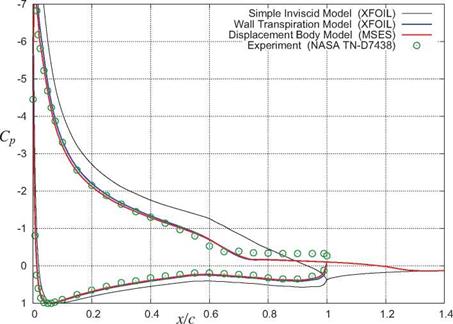Considerations in Flow Model Selection
The Simple Inviscid model shown is Figure 3.1 is attractive because it requires only the body geometry and the freestream velocity as inputs. Hence, it’s relatively simple to apply via any inviscid-flow theory or calculation method. For this reason it is often used as a first estimate, and whenever the viscous effects can be considered negligible, as for the small angles of attack in the GAW(1) airfoil example above.
Although the Displacement Body or Wall Transpiration models are clearly superior for all cases, they are considerably more complex to implement and to use. The major complication in their implementation is that they require knowledge of the boundary layer’s mass defect m(s) or displacement thickness S*(s) distributions. These quantities not known a priori, but must come from an analysis of the boundary layer itself (as treated in Chapter 4). Furthermore, the inviscid flow calculation and the boundary layer calculation are also coupled, in that the output of one is the input to the other. For this reason they must be solved in a coupled manner, as for example in the XFOIL 2D airfoil code [5]. This treatment is considerably more complex than the straightforward use of only an inviscid method, such as a panel method, in the Simple Inviscid model, especially for 3D flows. Section 4.12 gives further discussion of the coupling of inviscid and boundary layer flows.
|
|
 |
|
|
|
clо _ +0-5 Figure 3.8: Lift curves (dashed) of two GAW(1) displacement bodies with different camberline rear deflections. Viscous decambering correctly models the loss of lift and stall at high angles of attack. |
















